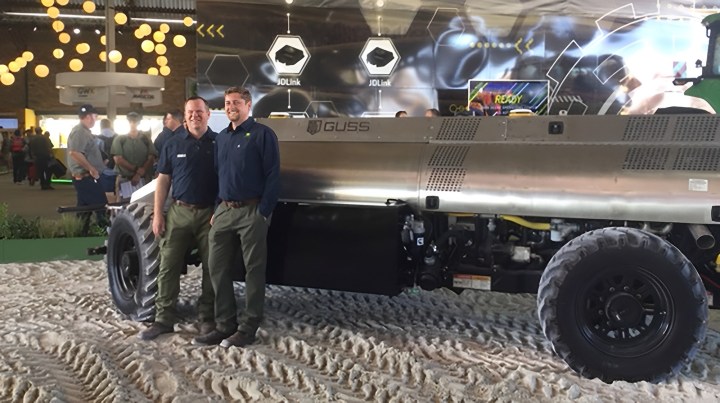MARCH OF TECHNOLOGY
Automation and precision farming bode ill for jobs in SA agriculture but are crucial for food security

Grain SA’s annual Nampo Harvest Day and agricultural show last week featured some of the latest technical innovations in farming. The bottom line is that this is good for food security but is likely to take a scythe to many agricultural jobs in South Africa.
In the US, the rise of the tractor between 1910 and 1960 replaced an estimated 24 million draught animals, according to the UN’s Food and Agriculture Organization. Now, more than a century after the tractor first gained traction, automation and digitisation threaten to put many agricultural workers out to pasture.
In a recent blog post on this issue, Aaron Smith, a professor of agricultural economics at the University of California, phrases it this way:
“The relevant question is not whether we will have mass unemployment, but what will happen to the specific workers who are replaced. Can they retrain and find new jobs? And what of their communities?”
His focus is on the US, where commercial farmers are having a tough time filling vacancies.
“Most people don’t like doing agricultural labor. It’s hard work and often bad for your health. For this reason, and due to increasing employment opportunities elsewhere in the economy, fewer workers are available for farmers to hire. They are choosing jobs in other sectors,” Smith writes, citing a 2020 survey that found 45% of California farmers had problems finding enough employees.
The US unemployment rate surged that year to — wait for it — over 8% because of the economic disruptions triggered by the Covid-19 pandemic. It now stands at a 50-year low of 3.4%, so one imagines that California farmers are finding field hands are even more scarce.
But the need for such hands is increasingly being reduced and some of the technology behind this trend is being developed in California. One of the hi-tech farming innovations from the state was on display last week at Grain SA’s agricultural trade show at the sprawling Nampo grounds near Bothaville in the northern Free State.
Meet Guss
Guss, which stands for Global Unmanned Spraying System, looks like something out of a sci-fi movie. Shaped like a horizontal cylinder on four wheels, as the name suggests it is an autonomous system for herbicide and other kinds of crop spraying. Guss is also the name of the privately held company behind the system.
There are only 200 in the world and the only one in South Africa was at Nampo at the stand featuring tractors and the like manufactured by John Deere, which holds a minority stake in Guss. Its application is for vineyards, macadamia nuts, citrus and stone fruit such as peaches.
“It has GPS but we have quite a few other sensors because GPS becomes pretty degraded among large trees such as pecans. Anywhere you have a canopy of leaves that block the GPS signal from the satellites,” Guss chief technology officer Chase Schapansky, who is the brains behind the system, told Daily Maverick.
Aside from being unmanned, which eliminates the need for a driver, Guss sprays in a targeted or precise manner, which eliminates wastage.
It is among the latest tools in the precision farming revolution which uses GPS and other technologies to precisely apply inputs to boost yields and productivity while cutting costs.
“Herbicide Guss is built with cutting-edge technology to detect, target and spot spray weeds, reducing chemical usage and drift for increased safety for the operator, environment, and food produced,” the company says on its website.
“Guss allows ag businesses to reskill workers — training them to use sophisticated technology that will open up future opportunities and positioning them for success in the economy of tomorrow.”
This is certainly one of the upshots of technological advancement. But South Africa is not the US, and while any advance in farm technology is welcome — especially given mounting concerns about food security — it will be viewed with trepidation by some, given the precarious social context that obtains here.
South Africa’s unemployment rate is almost 33%, and more than 42% under the expanded definition which includes discouraged job-seekers, according to the latest Quarterly Labour Force Survey (QLFS). The survey also found that South Africa’s agricultural sector employed 888,000 people. And unlike in the US, South Africa’s mostly low-skilled and poorly educated farmworkers will be hard-pressed to find jobs in other sectors.
Commercial agriculture in South Africa remains relatively labour-intensive. Simultaneously, it is highly capital-intensive and hi-tech. It would employ more people were it not for the technological trends already in play, but these have boosted production, profits and food security.
South Africa is currently reaping its third-highest maize harvest on record, which is testimony to technology and the rains of La Niña that have now ended. If it were not for this abundant harvest, food inflation would be running at an even faster pace than the 14-year high of 14% it reached in March.
Jobs will be mulched up
This technological furrow is only going to get ploughed further and jobs will get mulched up in the process. But the alternative would be falling behind the rest of the world, rendering an agricultural sector that accounts for about 11% of South Africa’s exports. And with the rand on the ropes, South Africa needs all the forex it can get its hands on.
There are many legitimate concerns and criticisms regarding big agriculture, ranging from environmental impacts to wealth concentration to price manipulation by traders in sometimes opaque supply chains.
Technology is also raising the threshold for entry into the commercial farming space, blocking the path for aspirant emerging farmers who lack the capital and know-how to enter this fast-changing field.
But precision farming can also mitigate ecological consequences by growing more on less land and with fewer inputs used with increased efficiency. There are various initiatives in play to adapt such technologies for smaller-scale farmers. The costs of new technologies tend to fall as they ripen in the market.
At the end of the day, you don’t want to be stuck with a horse when your neighbour has a tractor. DM



















Comments - Please login in order to comment.